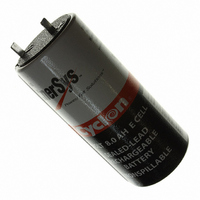0850-0004 EnerSys, 0850-0004 Datasheet - Page 16

0850-0004
Manufacturer Part Number
0850-0004
Description
BATT CYCLON SLA 2V 8.0AH
Manufacturer
EnerSys
Series
Cyclon®r
Specifications of 0850-0004
Voltage - Rated
2V
Capacity
8.0Ah
Size / Dimension
1.75" Dia x 3.94" H (44.5mm x 100.1mm)
Termination Style
Spade, .250" (6.3mm)
Rechargeability
Yes
Weight
1.1 lbs (498.95g)
Lead Free Status / RoHS Status
Lead free by exemption / RoHS compliant by exemption
Other names
842-1003
16
The impact of undercharging is felt much earlier than that of
overcharge. Hence, for cyclic applications, where the calendar
life is relatively short, it is very important to ensure that the
batteries are not undercharged. For cyclic applications, it is
preferable to err on the side of overcharge than on the side of
undercharge.
The recommended charge voltage for cyclic applications is
higher than that for float applications. This is due to the fact
that in cyclic applications the time available for a recharge is
substantially less than that for float applications. To compensate
for the shorter recharge time, the charging voltage, and thereby
the charging current, in cyclic applications is raised so that more
ampere-hours can be supplied to the battery in a given time.
7.3 Float Life
The design float life of CYCLON
to ten (10) years at room temperature (25°C/77°F) and under
proper charging conditions. This design life has been confirmed
by the use of accelerated testing methods that are widely
accepted by both manufacturers and users of sealed-lead
batteries. High temperatures are used to accelerate the aging
process of the battery under test.
The primary failure mode of CYCLON batteries can be defined
as positive current collecting grid corrosion and growth.
Because this corrosion and growth are the result of chemical
reactions within the cell, the rate of corrosion and growth
increases with increasing temperature as expressed by the
widely-accepted Arrhenius equation, which shows that the float
life of a VRLA cell is cut in half for roughly every 8°C (14.4°F)
rise in ambient temperature. Figure 7-2 shows this relationship
between ambient temperature and float life for CYCLON single
cells that have a float life of ten years at 25°C (77°F).
Figure 7-1: Cycle Life and DOD for CYCLON
A ten year battery, such as a CYCLON battery single cell pack
will last for five years at 33°C (91.4°F) and only 2 1/2 years at
41°C (105.8°F).
www.enersys.com
10
9
8
7
6
5
4
3
2
1
0
25
33°C
35
50% drop in float life for 8°C rise in
temperature
45
Ambient temperature °C
®
55
batteries is up to eight (8)
65
®
Battery Cells
75
85
8.1 Introduction
There are two main considerations relative to the application
of CYCLON cells and batteries that should be recognized to
assure that the usage is safe and proper. These are gassing and
shorting.
8.2 Gassing
Lead-acid batteries produce hydrogen and oxygen gases
internally during charging and overcharging. The gases
released or diffused must not be allowed to accumulate.
An explosion could occur if a spark were introduced.
During normal charging operation, some hydrogen gas is
released (vented) or diffused through the container walls.
The pure lead-tin grid construction as well as the extremely
high purity of lead oxides and sulfuric acid used in the
manufacture of the CYCLON battery cell all serve to
minimize the amount of hydrogen gas produced.
The minute quantities of gases that are released or diffused
from the CYCLON battery cell with recommended rates of
charge and overcharge will normally dissipate rapidly into the
atmosphere. Hydrogen gas is difficult to contain in anything but
a metal or glass enclosure. It can permeate a plastic container at
a relatively rapid rate.
Table 8-1 illustrates how little gas is generated by CYCLON
battery cells when they are under charge. The chart also shows
how much ventilation is needed to keep hydrogen gas below
1%, 2% and 4% concentration levels.
The use of this table can be understood by an example.
Suppose you have a 120V CYCLON pack using ten of the
12V, 25Ah BC cells packs and these batteries are in a float
application with the charger set at 2.27 VPC. As a safety
measure you want to design a ventilation system that will keep
hydrogen gas accumulation to less than 1%.
Looking at the 1% cell under the 2.27 VPC column (shaded and
boldfaced), each 12V BC pack will require 0.0032 cubic feet of
airflow per hour to limit the concentration of hydrogen to 1%.
Since there are ten 12V packs, the ventilation system should be
designed for an airflow of 0.032 cubic feet per hour. This is a
very small amount of airflow.
Because of the characteristics of gases and the relative difficulty
in containing them, most applications will allow for their release
into the atmosphere. If any CYCLON batteries are being
designed into a gas-tight container, precautions must be taken
so that the gases produced during charge can be released into
the atmosphere. If hydrogen is allowed to accumulate and mix
with the atmosphere at a concentration ranging from 4% to 75%
by volume, an explosive mixture is formed that would be ignited
in the presence of a flame or spark.
Chapter 8:
Safety Issues
Publication No: US-CYC-AM-007 - April 2008




















